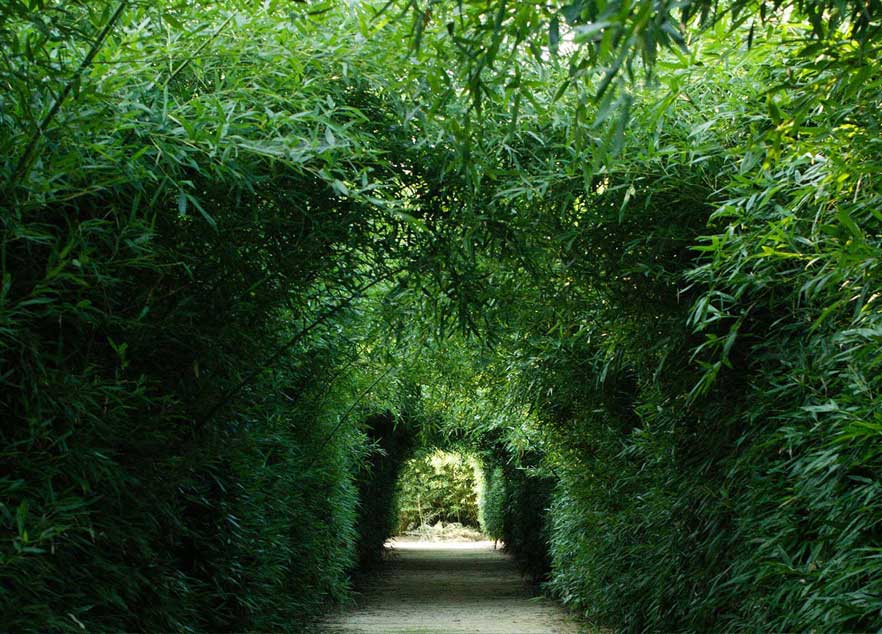For the past five years, I was the head of the Secretariat of the International Bamboo and Rattan Organisation (www.inbar.int) in Beijing, PR China. I stepped down in April this year, and now I am living in Europe again.
Europe is not a natural home of bamboo, but it is the main market for bamboo products primarily manufactured in Asia. Yet, there are many places where bamboos are already growing in this part of the world.
The Labirinto Della Masone in Italy is said to be the largest bamboo labyrinth in existence, made up of around 200,000 bamboo clumps. The labyrinth is located in Parma, near Milan, and I will be speaking at the “Under The Bamboo Tree” conference that will take place on 5 and 6 October 2019.

A few years ago, I was in Cornwall, UK and visited the Trebah botanical garden. I was surprised to see a large collection of very healthy bamboos, including the Chinese species Phyllostachys edulis. After my visit, I wrote about this on my blog:
https://hansfriederich.wordpress.com/2016/06/15/bamboos-in-cornwall-you-bet/

Cornwall is warm enough for bamboos to grow outside of the botanical garden. In fact, it grows so well in Cornwall that until the early 1950s it was grown as a commercial crop at several sites across Cornwall, with one farm producing 5 million culms per annum. Currently, some of the bamboos are used to make coffins, as there is a small company near Truro that produces bespoke funeral arrangements from bamboo: http://cornishbamboocoffins.co.uk/
I never visited the French bamboo garden, La Bambouseraie, but have heard a lot about it. The fact that the garden is doing so well illustrates that bamboos can also grow in mainland southern Europe. The former CEO of La Bambouseraie has established a 100 Ha nursery in Portugal, which now claims to be one of the largest bamboo nurseries in Europe:

There are other nurseries in Europe that specialize in bamboo, including Oprins in Belgium. Oprins specialises in Fargesia, a non-invasive group of bamboo species, and production techniques are based on tissue culture.
All of this made me realise that bamboos could provide an innovative development trajectory for poor local communities, especially in southern Europe, and I have been looking for an opportunity to work on this. I have read about the decline of agriculture in countries like Portugal and Spain, and bamboo plantations could provide jobs for disillusioned farmers. Planting bamboo would also regenerate the productivity of the exhausted soils, as INBAR and FAO have shown through a number of case studies around the world Finally, bamboo could create a very effective natural carbon sink, and this fits with the political agenda of all European nations.

I am therefore pleased to announce that I will soon be working with Bamboologic in the Netherlands (www.bambulogic.eu) to help create the European Bamboo Programme. The aim of the Programme is the creation of local jobs, restoration of degraded farmland and mitigation of climate change by planting and managing bamboo, starting in Southern Portugal. We have identified this to be a particularly suitable location for bamboo, and have acquired a 150 hectares start-up location in the Municipality of Alcoutim. Planting will start before the end of the year and the area will be expanded to 2000 hectares in the near future.
Some people have expressed reservations about using bamboo for land restoration, but as we are considering this an agricultural development programme, the potential risks can be managed, and any perceived negative ecological effects will be mitigated.
Eventually, the programme aims to plant 8000 hectares of unproductive agricultural land with bamboo in different countries in southern Europe and to establish several processing factories, but that will take some time. At this moment, we are starting phase 1, and we are looking for partners to develop the second phase of the programme.


Hello Sir. I have a land in North central Portugal and I want to grow Bamboo here. I just want to know how is it possible? And how can I get expert advice?
Thank You,.
Dear Trilok
I will send an email from my gmail account.
Best regards
Hans
Hello sir,
I am Crispaus, and I write to you from Nairobi, Kenya.
I love reading this article on the importance and role of bamboo and its allied advantages for humanity and the environment as a whole. I am an Agroforestry and Rural Development graduate myself and I have my fair share of absolute support for cultivation and propagation of all sorts of trees. Further I am now indulged in visual media (read photography, illustration and fine art) and I would love to collaborate with you on your indulgence in Bamboo.
I am equally open to referrals to any other organizations that you know of that are in need of such a capacity in skills that are engaged in the natural resources sector.
Aside with that, I am also a blogger of matters rugby as a hobby on wordpress, the link is attached below.
More importantly though, keep up the great work on educating us on nature, more so Bamboo species. 👌🏽😊
Kind regards.
Hi Hans,
Looking at retiring in Portugal and interested to purchase some arable farming ground, was amazed to find your report and vision, very interested to cultivate bamboo as a “cash crop”. Can you send some details about your ideas, especially areas in Portugal more suited than others.
Dear Neil
Thanks for your message. You can find more details on the https://bamboologic.eu/ website.
I am afraid I do not know Portugal well enough to advise on which areas are suitable. Our decision was partially based on the strong local support, and I would suggest that is your main requirement.
Good luck and best regards
Hans
I live in central Portugal on my homestead & am very interested in growing bamboo. How do I get involved? Sara
Hi Sara.
Thanks for reaching out.
Please send an email to hansfr55@gmail.com and I will get back to you.